Project Management: Disciplines and Feasibility Methods
VerifiedAdded on 2022/11/14
|16
|4037
|52
AI Summary
This paper discusses the disciplines of project management and their effectiveness for organizations, as well as project feasibility methods and the role of people and teams. It covers project management methods, models, and underpinned theories, value of project planning methods, risk management methods, and more.
Contribute Materials
Your contribution can guide someone’s learning journey. Share your
documents today.
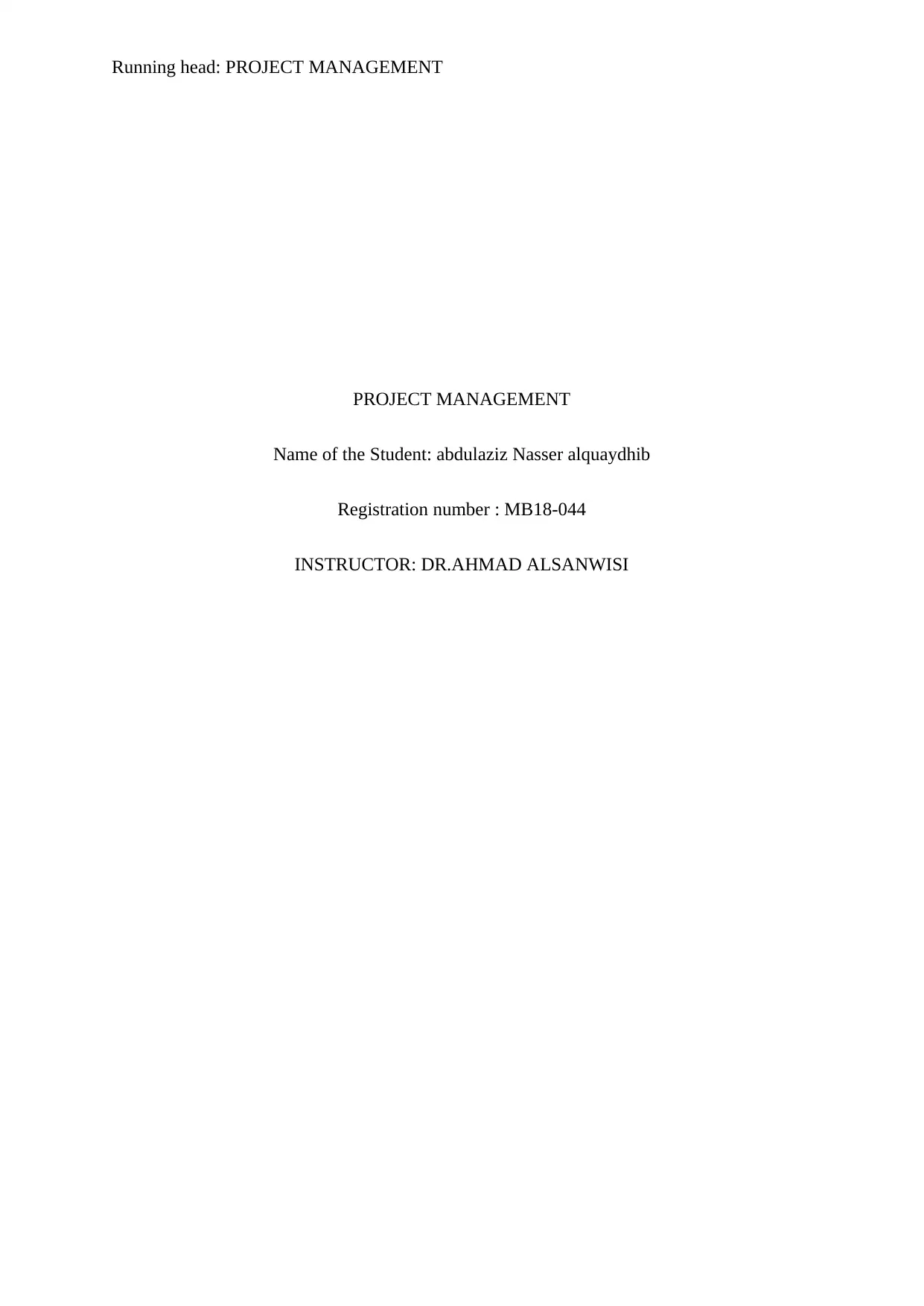
Running head: PROJECT MANAGEMENT
PROJECT MANAGEMENT
Name of the Student: abdulaziz Nasser alquaydhib
Registration number : MB18-044
INSTRUCTOR: DR.AHMAD ALSANWISI
PROJECT MANAGEMENT
Name of the Student: abdulaziz Nasser alquaydhib
Registration number : MB18-044
INSTRUCTOR: DR.AHMAD ALSANWISI
Secure Best Marks with AI Grader
Need help grading? Try our AI Grader for instant feedback on your assignments.
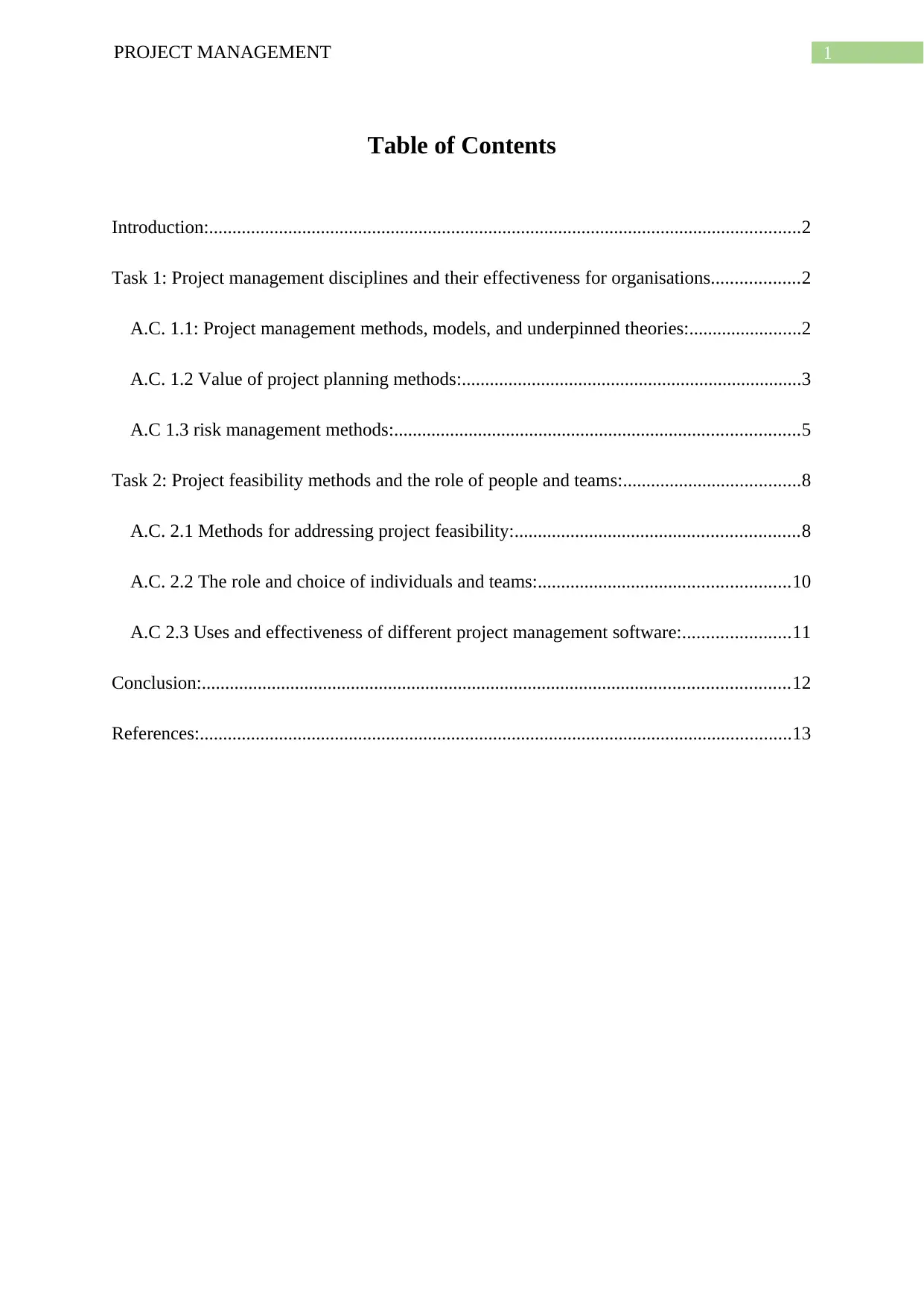
PROJECT MANAGEMENT 1
Table of Contents
Introduction:...............................................................................................................................2
Task 1: Project management disciplines and their effectiveness for organisations...................2
A.C. 1.1: Project management methods, models, and underpinned theories:........................2
A.C. 1.2 Value of project planning methods:.........................................................................3
A.C 1.3 risk management methods:.......................................................................................5
Task 2: Project feasibility methods and the role of people and teams:......................................8
A.C. 2.1 Methods for addressing project feasibility:.............................................................8
A.C. 2.2 The role and choice of individuals and teams:......................................................10
A.C 2.3 Uses and effectiveness of different project management software:.......................11
Conclusion:..............................................................................................................................12
References:...............................................................................................................................13
Table of Contents
Introduction:...............................................................................................................................2
Task 1: Project management disciplines and their effectiveness for organisations...................2
A.C. 1.1: Project management methods, models, and underpinned theories:........................2
A.C. 1.2 Value of project planning methods:.........................................................................3
A.C 1.3 risk management methods:.......................................................................................5
Task 2: Project feasibility methods and the role of people and teams:......................................8
A.C. 2.1 Methods for addressing project feasibility:.............................................................8
A.C. 2.2 The role and choice of individuals and teams:......................................................10
A.C 2.3 Uses and effectiveness of different project management software:.......................11
Conclusion:..............................................................................................................................12
References:...............................................................................................................................13
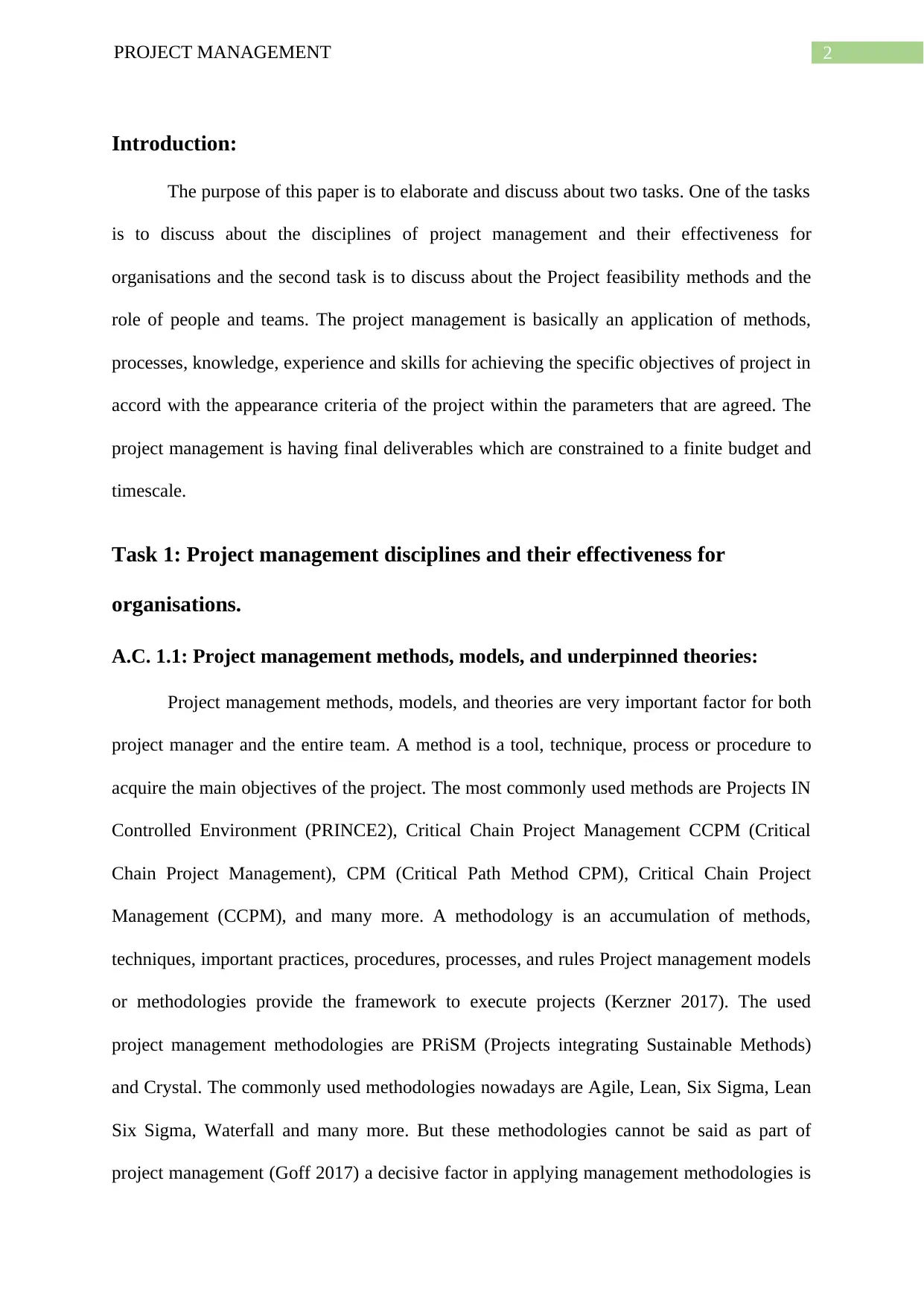
2PROJECT MANAGEMENT
Introduction:
The purpose of this paper is to elaborate and discuss about two tasks. One of the tasks
is to discuss about the disciplines of project management and their effectiveness for
organisations and the second task is to discuss about the Project feasibility methods and the
role of people and teams. The project management is basically an application of methods,
processes, knowledge, experience and skills for achieving the specific objectives of project in
accord with the appearance criteria of the project within the parameters that are agreed. The
project management is having final deliverables which are constrained to a finite budget and
timescale.
Task 1: Project management disciplines and their effectiveness for
organisations.
A.C. 1.1: Project management methods, models, and underpinned theories:
Project management methods, models, and theories are very important factor for both
project manager and the entire team. A method is a tool, technique, process or procedure to
acquire the main objectives of the project. The most commonly used methods are Projects IN
Controlled Environment (PRINCE2), Critical Chain Project Management CCPM (Critical
Chain Project Management), CPM (Critical Path Method CPM), Critical Chain Project
Management (CCPM), and many more. A methodology is an accumulation of methods,
techniques, important practices, procedures, processes, and rules Project management models
or methodologies provide the framework to execute projects (Kerzner 2017). The used
project management methodologies are PRiSM (Projects integrating Sustainable Methods)
and Crystal. The commonly used methodologies nowadays are Agile, Lean, Six Sigma, Lean
Six Sigma, Waterfall and many more. But these methodologies cannot be said as part of
project management (Goff 2017) a decisive factor in applying management methodologies is
Introduction:
The purpose of this paper is to elaborate and discuss about two tasks. One of the tasks
is to discuss about the disciplines of project management and their effectiveness for
organisations and the second task is to discuss about the Project feasibility methods and the
role of people and teams. The project management is basically an application of methods,
processes, knowledge, experience and skills for achieving the specific objectives of project in
accord with the appearance criteria of the project within the parameters that are agreed. The
project management is having final deliverables which are constrained to a finite budget and
timescale.
Task 1: Project management disciplines and their effectiveness for
organisations.
A.C. 1.1: Project management methods, models, and underpinned theories:
Project management methods, models, and theories are very important factor for both
project manager and the entire team. A method is a tool, technique, process or procedure to
acquire the main objectives of the project. The most commonly used methods are Projects IN
Controlled Environment (PRINCE2), Critical Chain Project Management CCPM (Critical
Chain Project Management), CPM (Critical Path Method CPM), Critical Chain Project
Management (CCPM), and many more. A methodology is an accumulation of methods,
techniques, important practices, procedures, processes, and rules Project management models
or methodologies provide the framework to execute projects (Kerzner 2017). The used
project management methodologies are PRiSM (Projects integrating Sustainable Methods)
and Crystal. The commonly used methodologies nowadays are Agile, Lean, Six Sigma, Lean
Six Sigma, Waterfall and many more. But these methodologies cannot be said as part of
project management (Goff 2017) a decisive factor in applying management methodologies is
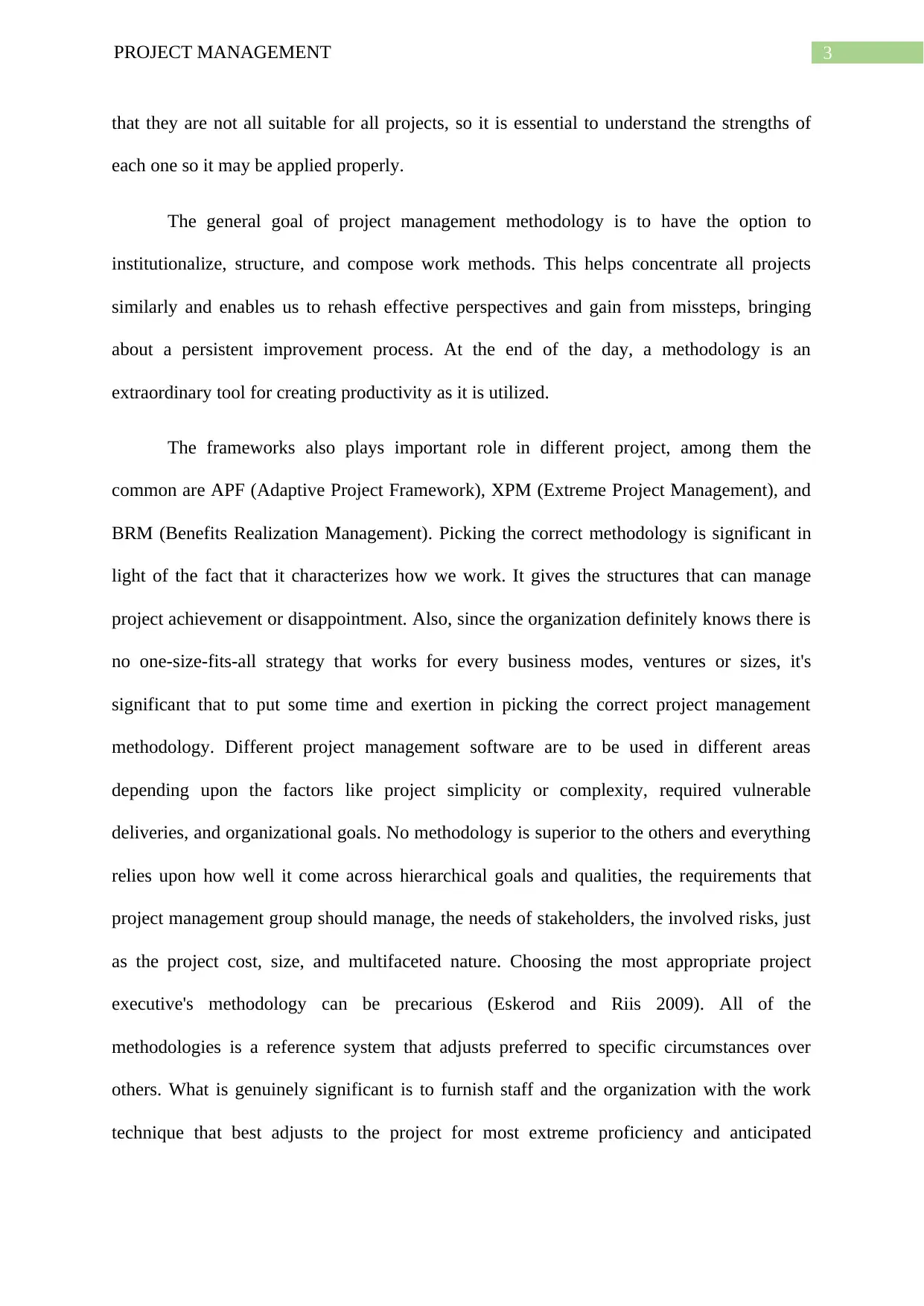
3PROJECT MANAGEMENT
that they are not all suitable for all projects, so it is essential to understand the strengths of
each one so it may be applied properly.
The general goal of project management methodology is to have the option to
institutionalize, structure, and compose work methods. This helps concentrate all projects
similarly and enables us to rehash effective perspectives and gain from missteps, bringing
about a persistent improvement process. At the end of the day, a methodology is an
extraordinary tool for creating productivity as it is utilized.
The frameworks also plays important role in different project, among them the
common are APF (Adaptive Project Framework), XPM (Extreme Project Management), and
BRM (Benefits Realization Management). Picking the correct methodology is significant in
light of the fact that it characterizes how we work. It gives the structures that can manage
project achievement or disappointment. Also, since the organization definitely knows there is
no one-size-fits-all strategy that works for every business modes, ventures or sizes, it's
significant that to put some time and exertion in picking the correct project management
methodology. Different project management software are to be used in different areas
depending upon the factors like project simplicity or complexity, required vulnerable
deliveries, and organizational goals. No methodology is superior to the others and everything
relies upon how well it come across hierarchical goals and qualities, the requirements that
project management group should manage, the needs of stakeholders, the involved risks, just
as the project cost, size, and multifaceted nature. Choosing the most appropriate project
executive's methodology can be precarious (Eskerod and Riis 2009). All of the
methodologies is a reference system that adjusts preferred to specific circumstances over
others. What is genuinely significant is to furnish staff and the organization with the work
technique that best adjusts to the project for most extreme proficiency and anticipated
that they are not all suitable for all projects, so it is essential to understand the strengths of
each one so it may be applied properly.
The general goal of project management methodology is to have the option to
institutionalize, structure, and compose work methods. This helps concentrate all projects
similarly and enables us to rehash effective perspectives and gain from missteps, bringing
about a persistent improvement process. At the end of the day, a methodology is an
extraordinary tool for creating productivity as it is utilized.
The frameworks also plays important role in different project, among them the
common are APF (Adaptive Project Framework), XPM (Extreme Project Management), and
BRM (Benefits Realization Management). Picking the correct methodology is significant in
light of the fact that it characterizes how we work. It gives the structures that can manage
project achievement or disappointment. Also, since the organization definitely knows there is
no one-size-fits-all strategy that works for every business modes, ventures or sizes, it's
significant that to put some time and exertion in picking the correct project management
methodology. Different project management software are to be used in different areas
depending upon the factors like project simplicity or complexity, required vulnerable
deliveries, and organizational goals. No methodology is superior to the others and everything
relies upon how well it come across hierarchical goals and qualities, the requirements that
project management group should manage, the needs of stakeholders, the involved risks, just
as the project cost, size, and multifaceted nature. Choosing the most appropriate project
executive's methodology can be precarious (Eskerod and Riis 2009). All of the
methodologies is a reference system that adjusts preferred to specific circumstances over
others. What is genuinely significant is to furnish staff and the organization with the work
technique that best adjusts to the project for most extreme proficiency and anticipated
Paraphrase This Document
Need a fresh take? Get an instant paraphrase of this document with our AI Paraphraser

4PROJECT MANAGEMENT
outcomes. It relies upon such a large number of factors, a significant number of which are
outside of the control of project managers.
A.C. 1.2 Value of project planning methods:
Different project management methodologies, models and framework are carried out
for different needs in different project. A decent project management model delivers the
processes, framework, techniques and guidelines to manage the persons and attain the project
goals. Generally, good models does enhance the odds of required project success and
therefore delivers value to company, the beneficiaries, the donor and the project (Gist and
Langley 2017).The cost of implementing and developing a project management model are
offset by completing projects efficiently and effectually, improved outcome through better
planning, resolving difficulties speedily, resolving the upcoming risks before it occurs,
managing expectancy with stakeholders extra efficiently and by upgraded financial
management Such as, PRINCE2 is a project management strategy that authorizes the need to
part project responsibility among the board and a project manager.PRINCE2 is best for
architecture, marketing and construction, and also works for different companies (Garcia
2015). Whereas, CCPM method centers on a project’s planning, estimating progress,
informing activity completion, decreasing duration estimates, calculating buffers and setting
needs. CCPM method is best for construction and manufacturing. The CPM is another
method used for establishing the significance of project activities, evaluating risks,
reassigning team roles, and to hand out resources to all (Mir Pinnington 2014). The CPM is
best obtain for construction companies, architecture companies, engineering and also can be
used for others companies. XPM and Crystal are the methodologies best for software
development. APF (focusses on environment) and BRM (focusses upon benefits) are best for
Information Technology. Rather than the above methods there are other methods, models and
frameworks, which helps in different organization and business objectives. Agile, Scrum,
outcomes. It relies upon such a large number of factors, a significant number of which are
outside of the control of project managers.
A.C. 1.2 Value of project planning methods:
Different project management methodologies, models and framework are carried out
for different needs in different project. A decent project management model delivers the
processes, framework, techniques and guidelines to manage the persons and attain the project
goals. Generally, good models does enhance the odds of required project success and
therefore delivers value to company, the beneficiaries, the donor and the project (Gist and
Langley 2017).The cost of implementing and developing a project management model are
offset by completing projects efficiently and effectually, improved outcome through better
planning, resolving difficulties speedily, resolving the upcoming risks before it occurs,
managing expectancy with stakeholders extra efficiently and by upgraded financial
management Such as, PRINCE2 is a project management strategy that authorizes the need to
part project responsibility among the board and a project manager.PRINCE2 is best for
architecture, marketing and construction, and also works for different companies (Garcia
2015). Whereas, CCPM method centers on a project’s planning, estimating progress,
informing activity completion, decreasing duration estimates, calculating buffers and setting
needs. CCPM method is best for construction and manufacturing. The CPM is another
method used for establishing the significance of project activities, evaluating risks,
reassigning team roles, and to hand out resources to all (Mir Pinnington 2014). The CPM is
best obtain for construction companies, architecture companies, engineering and also can be
used for others companies. XPM and Crystal are the methodologies best for software
development. APF (focusses on environment) and BRM (focusses upon benefits) are best for
Information Technology. Rather than the above methods there are other methods, models and
frameworks, which helps in different organization and business objectives. Agile, Scrum,
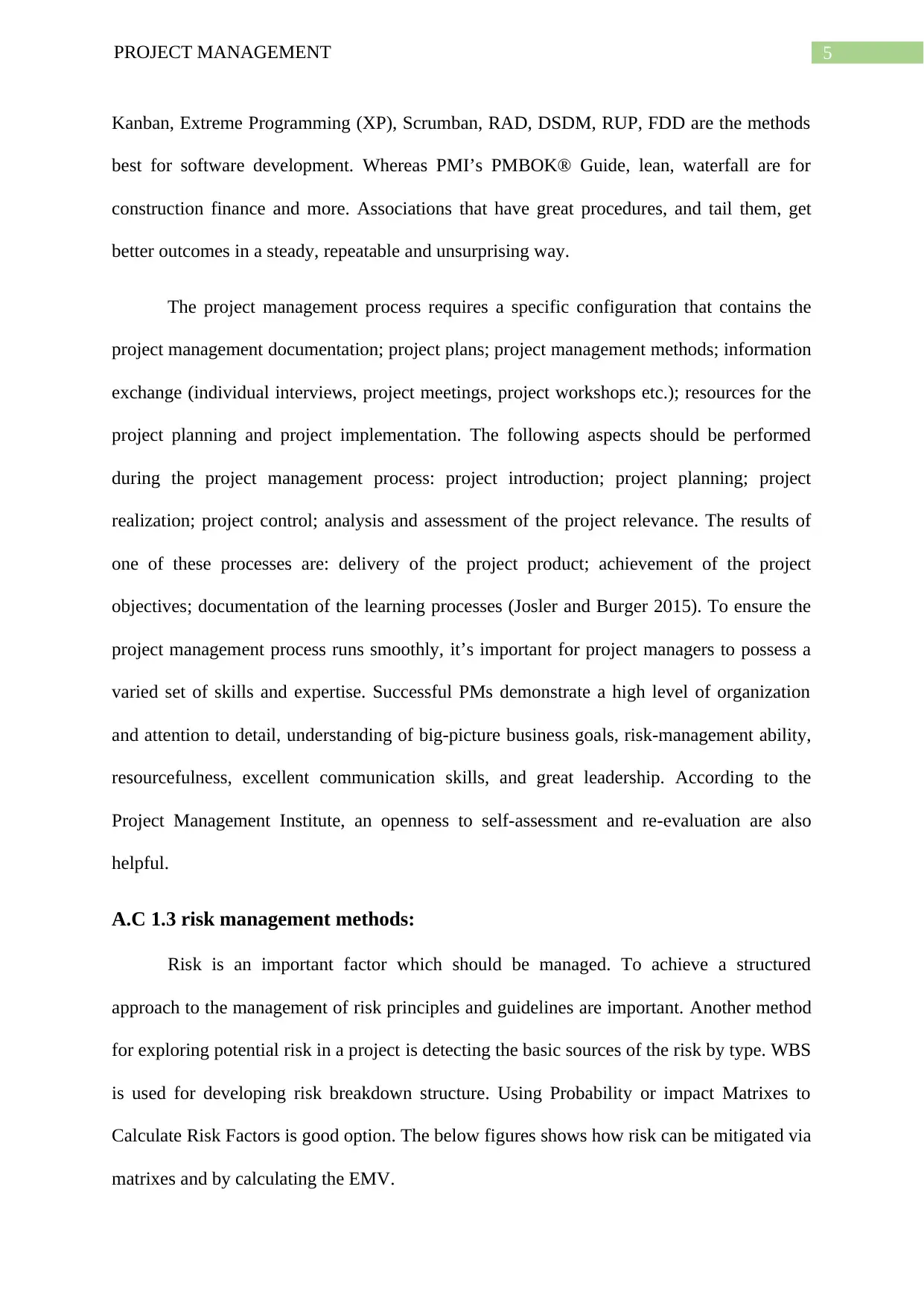
5PROJECT MANAGEMENT
Kanban, Extreme Programming (XP), Scrumban, RAD, DSDM, RUP, FDD are the methods
best for software development. Whereas PMI’s PMBOK® Guide, lean, waterfall are for
construction finance and more. Associations that have great procedures, and tail them, get
better outcomes in a steady, repeatable and unsurprising way.
The project management process requires a specific configuration that contains the
project management documentation; project plans; project management methods; information
exchange (individual interviews, project meetings, project workshops etc.); resources for the
project planning and project implementation. The following aspects should be performed
during the project management process: project introduction; project planning; project
realization; project control; analysis and assessment of the project relevance. The results of
one of these processes are: delivery of the project product; achievement of the project
objectives; documentation of the learning processes (Josler and Burger 2015). To ensure the
project management process runs smoothly, it’s important for project managers to possess a
varied set of skills and expertise. Successful PMs demonstrate a high level of organization
and attention to detail, understanding of big-picture business goals, risk-management ability,
resourcefulness, excellent communication skills, and great leadership. According to the
Project Management Institute, an openness to self-assessment and re-evaluation are also
helpful.
A.C 1.3 risk management methods:
Risk is an important factor which should be managed. To achieve a structured
approach to the management of risk principles and guidelines are important. Another method
for exploring potential risk in a project is detecting the basic sources of the risk by type. WBS
is used for developing risk breakdown structure. Using Probability or impact Matrixes to
Calculate Risk Factors is good option. The below figures shows how risk can be mitigated via
matrixes and by calculating the EMV.
Kanban, Extreme Programming (XP), Scrumban, RAD, DSDM, RUP, FDD are the methods
best for software development. Whereas PMI’s PMBOK® Guide, lean, waterfall are for
construction finance and more. Associations that have great procedures, and tail them, get
better outcomes in a steady, repeatable and unsurprising way.
The project management process requires a specific configuration that contains the
project management documentation; project plans; project management methods; information
exchange (individual interviews, project meetings, project workshops etc.); resources for the
project planning and project implementation. The following aspects should be performed
during the project management process: project introduction; project planning; project
realization; project control; analysis and assessment of the project relevance. The results of
one of these processes are: delivery of the project product; achievement of the project
objectives; documentation of the learning processes (Josler and Burger 2015). To ensure the
project management process runs smoothly, it’s important for project managers to possess a
varied set of skills and expertise. Successful PMs demonstrate a high level of organization
and attention to detail, understanding of big-picture business goals, risk-management ability,
resourcefulness, excellent communication skills, and great leadership. According to the
Project Management Institute, an openness to self-assessment and re-evaluation are also
helpful.
A.C 1.3 risk management methods:
Risk is an important factor which should be managed. To achieve a structured
approach to the management of risk principles and guidelines are important. Another method
for exploring potential risk in a project is detecting the basic sources of the risk by type. WBS
is used for developing risk breakdown structure. Using Probability or impact Matrixes to
Calculate Risk Factors is good option. The below figures shows how risk can be mitigated via
matrixes and by calculating the EMV.
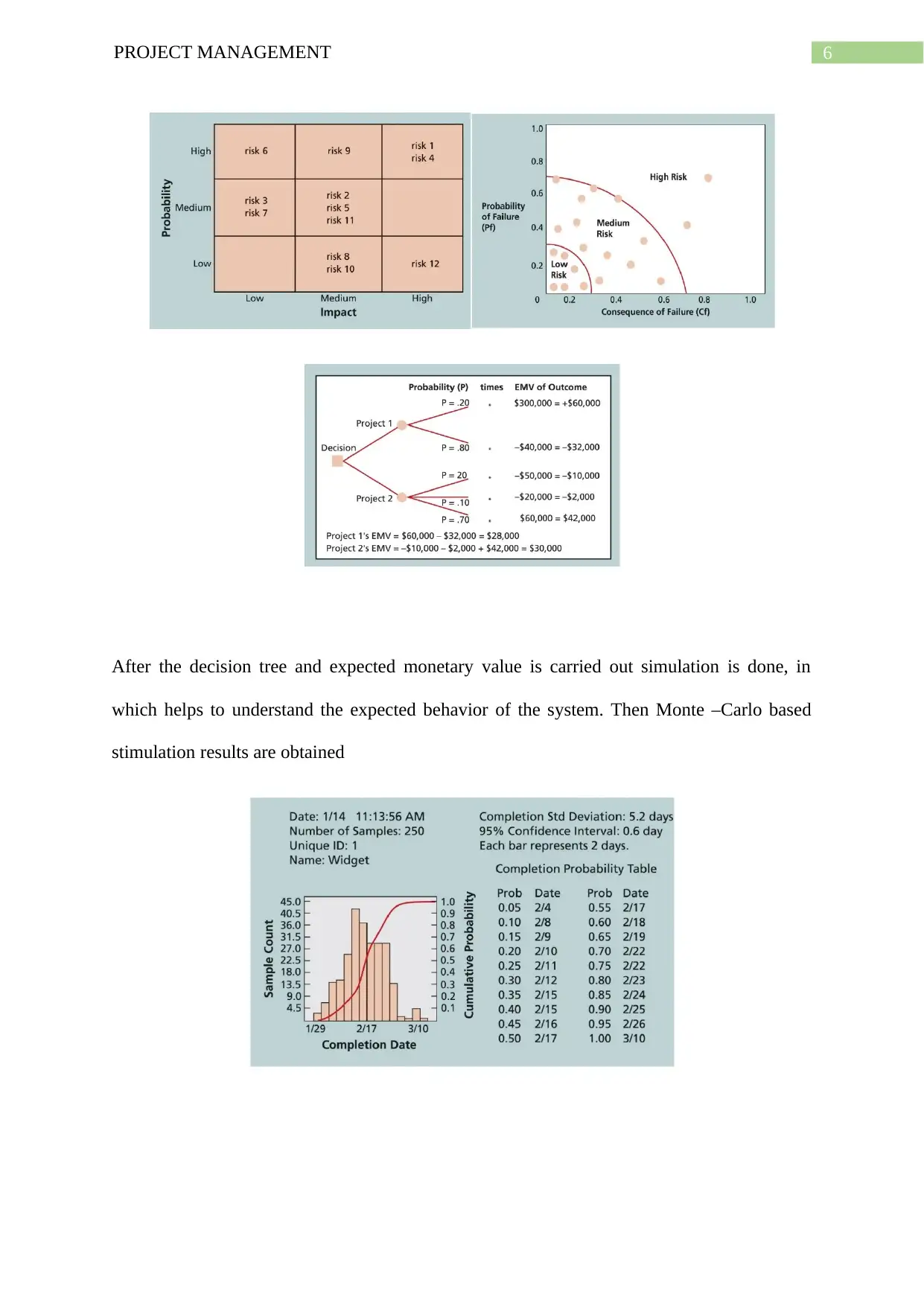
6PROJECT MANAGEMENT
After the decision tree and expected monetary value is carried out simulation is done, in
which helps to understand the expected behavior of the system. Then Monte –Carlo based
stimulation results are obtained
After the decision tree and expected monetary value is carried out simulation is done, in
which helps to understand the expected behavior of the system. Then Monte –Carlo based
stimulation results are obtained
Secure Best Marks with AI Grader
Need help grading? Try our AI Grader for instant feedback on your assignments.
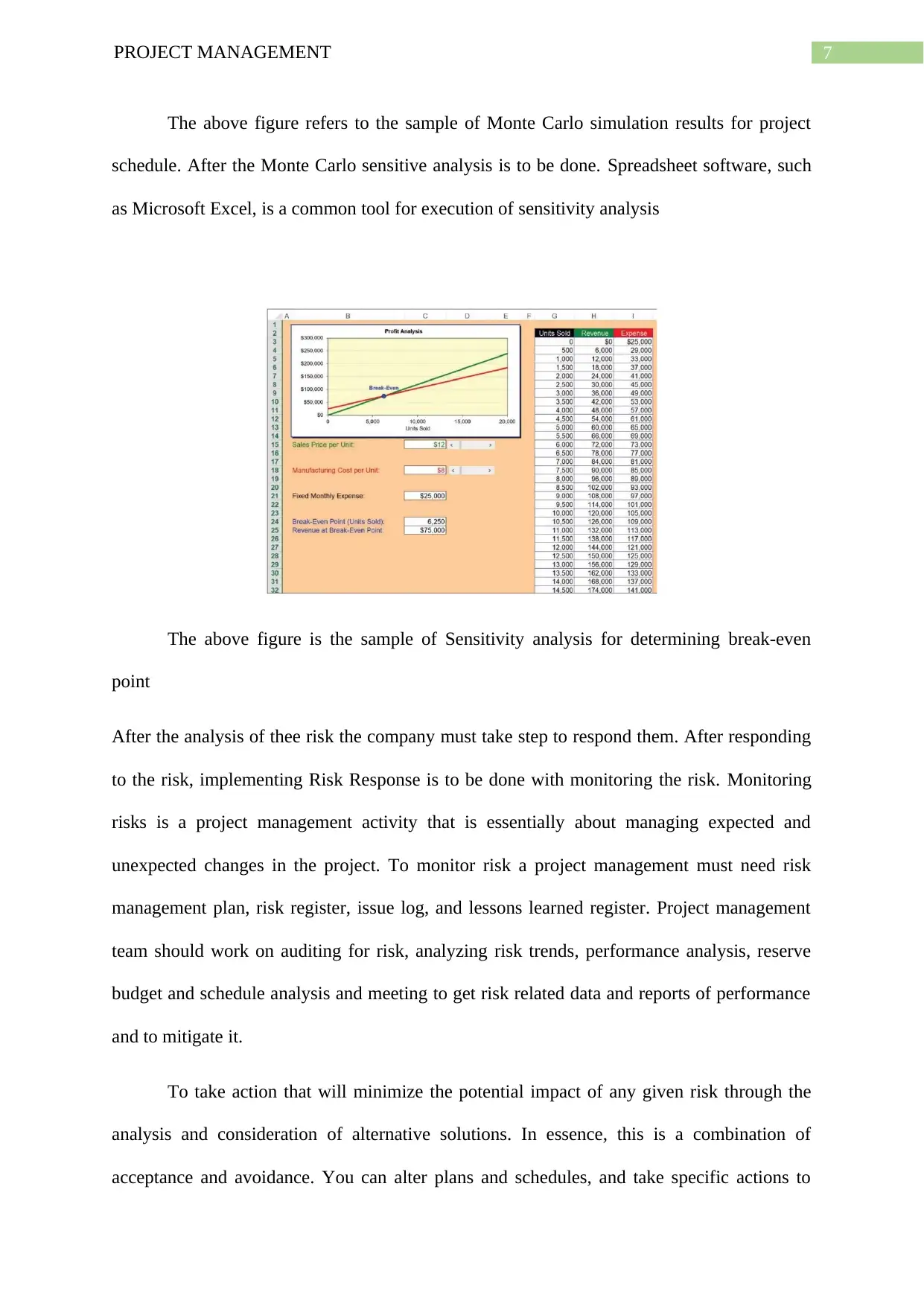
7PROJECT MANAGEMENT
The above figure refers to the sample of Monte Carlo simulation results for project
schedule. After the Monte Carlo sensitive analysis is to be done. Spreadsheet software, such
as Microsoft Excel, is a common tool for execution of sensitivity analysis
The above figure is the sample of Sensitivity analysis for determining break-even
point
After the analysis of thee risk the company must take step to respond them. After responding
to the risk, implementing Risk Response is to be done with monitoring the risk. Monitoring
risks is a project management activity that is essentially about managing expected and
unexpected changes in the project. To monitor risk a project management must need risk
management plan, risk register, issue log, and lessons learned register. Project management
team should work on auditing for risk, analyzing risk trends, performance analysis, reserve
budget and schedule analysis and meeting to get risk related data and reports of performance
and to mitigate it.
To take action that will minimize the potential impact of any given risk through the
analysis and consideration of alternative solutions. In essence, this is a combination of
acceptance and avoidance. You can alter plans and schedules, and take specific actions to
The above figure refers to the sample of Monte Carlo simulation results for project
schedule. After the Monte Carlo sensitive analysis is to be done. Spreadsheet software, such
as Microsoft Excel, is a common tool for execution of sensitivity analysis
The above figure is the sample of Sensitivity analysis for determining break-even
point
After the analysis of thee risk the company must take step to respond them. After responding
to the risk, implementing Risk Response is to be done with monitoring the risk. Monitoring
risks is a project management activity that is essentially about managing expected and
unexpected changes in the project. To monitor risk a project management must need risk
management plan, risk register, issue log, and lessons learned register. Project management
team should work on auditing for risk, analyzing risk trends, performance analysis, reserve
budget and schedule analysis and meeting to get risk related data and reports of performance
and to mitigate it.
To take action that will minimize the potential impact of any given risk through the
analysis and consideration of alternative solutions. In essence, this is a combination of
acceptance and avoidance. You can alter plans and schedules, and take specific actions to
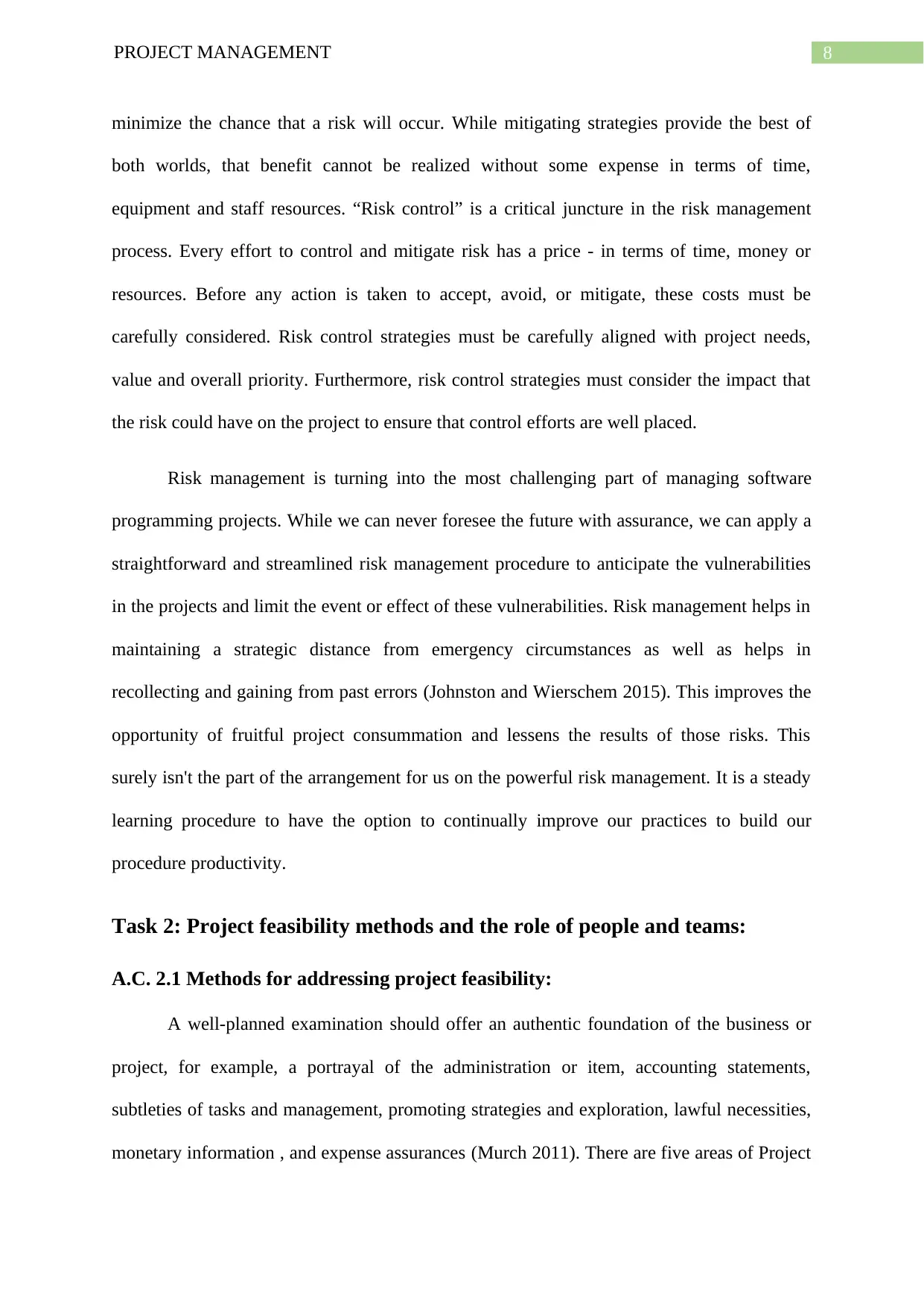
8PROJECT MANAGEMENT
minimize the chance that a risk will occur. While mitigating strategies provide the best of
both worlds, that benefit cannot be realized without some expense in terms of time,
equipment and staff resources. “Risk control” is a critical juncture in the risk management
process. Every effort to control and mitigate risk has a price - in terms of time, money or
resources. Before any action is taken to accept, avoid, or mitigate, these costs must be
carefully considered. Risk control strategies must be carefully aligned with project needs,
value and overall priority. Furthermore, risk control strategies must consider the impact that
the risk could have on the project to ensure that control efforts are well placed.
Risk management is turning into the most challenging part of managing software
programming projects. While we can never foresee the future with assurance, we can apply a
straightforward and streamlined risk management procedure to anticipate the vulnerabilities
in the projects and limit the event or effect of these vulnerabilities. Risk management helps in
maintaining a strategic distance from emergency circumstances as well as helps in
recollecting and gaining from past errors (Johnston and Wierschem 2015). This improves the
opportunity of fruitful project consummation and lessens the results of those risks. This
surely isn't the part of the arrangement for us on the powerful risk management. It is a steady
learning procedure to have the option to continually improve our practices to build our
procedure productivity.
Task 2: Project feasibility methods and the role of people and teams:
A.C. 2.1 Methods for addressing project feasibility:
A well-planned examination should offer an authentic foundation of the business or
project, for example, a portrayal of the administration or item, accounting statements,
subtleties of tasks and management, promoting strategies and exploration, lawful necessities,
monetary information , and expense assurances (Murch 2011). There are five areas of Project
minimize the chance that a risk will occur. While mitigating strategies provide the best of
both worlds, that benefit cannot be realized without some expense in terms of time,
equipment and staff resources. “Risk control” is a critical juncture in the risk management
process. Every effort to control and mitigate risk has a price - in terms of time, money or
resources. Before any action is taken to accept, avoid, or mitigate, these costs must be
carefully considered. Risk control strategies must be carefully aligned with project needs,
value and overall priority. Furthermore, risk control strategies must consider the impact that
the risk could have on the project to ensure that control efforts are well placed.
Risk management is turning into the most challenging part of managing software
programming projects. While we can never foresee the future with assurance, we can apply a
straightforward and streamlined risk management procedure to anticipate the vulnerabilities
in the projects and limit the event or effect of these vulnerabilities. Risk management helps in
maintaining a strategic distance from emergency circumstances as well as helps in
recollecting and gaining from past errors (Johnston and Wierschem 2015). This improves the
opportunity of fruitful project consummation and lessens the results of those risks. This
surely isn't the part of the arrangement for us on the powerful risk management. It is a steady
learning procedure to have the option to continually improve our practices to build our
procedure productivity.
Task 2: Project feasibility methods and the role of people and teams:
A.C. 2.1 Methods for addressing project feasibility:
A well-planned examination should offer an authentic foundation of the business or
project, for example, a portrayal of the administration or item, accounting statements,
subtleties of tasks and management, promoting strategies and exploration, lawful necessities,
monetary information , and expense assurances (Murch 2011). There are five areas of Project
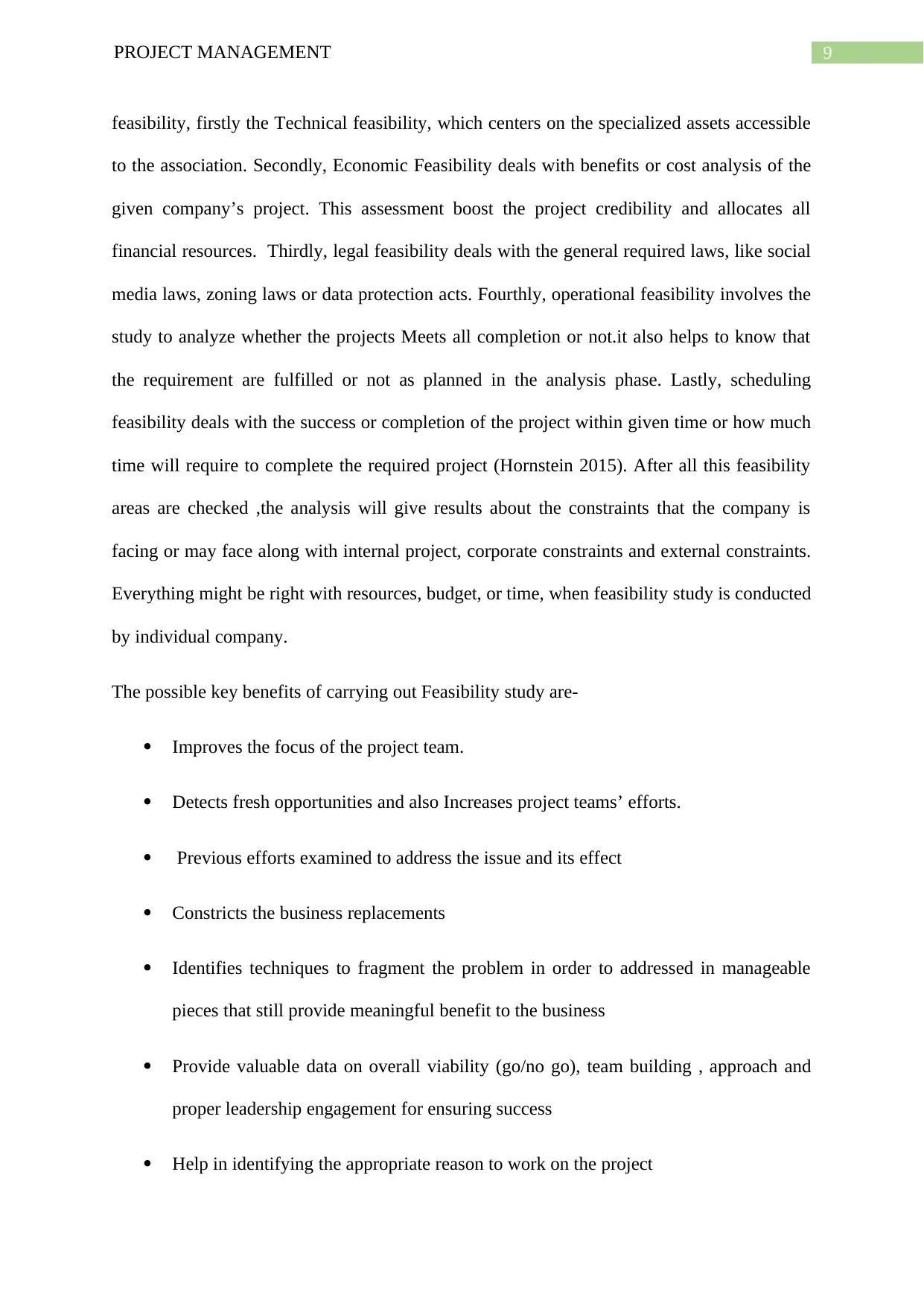
9PROJECT MANAGEMENT
feasibility, firstly the Technical feasibility, which centers on the specialized assets accessible
to the association. Secondly, Economic Feasibility deals with benefits or cost analysis of the
given company’s project. This assessment boost the project credibility and allocates all
financial resources. Thirdly, legal feasibility deals with the general required laws, like social
media laws, zoning laws or data protection acts. Fourthly, operational feasibility involves the
study to analyze whether the projects Meets all completion or not.it also helps to know that
the requirement are fulfilled or not as planned in the analysis phase. Lastly, scheduling
feasibility deals with the success or completion of the project within given time or how much
time will require to complete the required project (Hornstein 2015). After all this feasibility
areas are checked ,the analysis will give results about the constraints that the company is
facing or may face along with internal project, corporate constraints and external constraints.
Everything might be right with resources, budget, or time, when feasibility study is conducted
by individual company.
The possible key benefits of carrying out Feasibility study are-
Improves the focus of the project team.
Detects fresh opportunities and also Increases project teams’ efforts.
Previous efforts examined to address the issue and its effect
Constricts the business replacements
Identifies techniques to fragment the problem in order to addressed in manageable
pieces that still provide meaningful benefit to the business
Provide valuable data on overall viability (go/no go), team building , approach and
proper leadership engagement for ensuring success
Help in identifying the appropriate reason to work on the project
feasibility, firstly the Technical feasibility, which centers on the specialized assets accessible
to the association. Secondly, Economic Feasibility deals with benefits or cost analysis of the
given company’s project. This assessment boost the project credibility and allocates all
financial resources. Thirdly, legal feasibility deals with the general required laws, like social
media laws, zoning laws or data protection acts. Fourthly, operational feasibility involves the
study to analyze whether the projects Meets all completion or not.it also helps to know that
the requirement are fulfilled or not as planned in the analysis phase. Lastly, scheduling
feasibility deals with the success or completion of the project within given time or how much
time will require to complete the required project (Hornstein 2015). After all this feasibility
areas are checked ,the analysis will give results about the constraints that the company is
facing or may face along with internal project, corporate constraints and external constraints.
Everything might be right with resources, budget, or time, when feasibility study is conducted
by individual company.
The possible key benefits of carrying out Feasibility study are-
Improves the focus of the project team.
Detects fresh opportunities and also Increases project teams’ efforts.
Previous efforts examined to address the issue and its effect
Constricts the business replacements
Identifies techniques to fragment the problem in order to addressed in manageable
pieces that still provide meaningful benefit to the business
Provide valuable data on overall viability (go/no go), team building , approach and
proper leadership engagement for ensuring success
Help in identifying the appropriate reason to work on the project
Paraphrase This Document
Need a fresh take? Get an instant paraphrase of this document with our AI Paraphraser
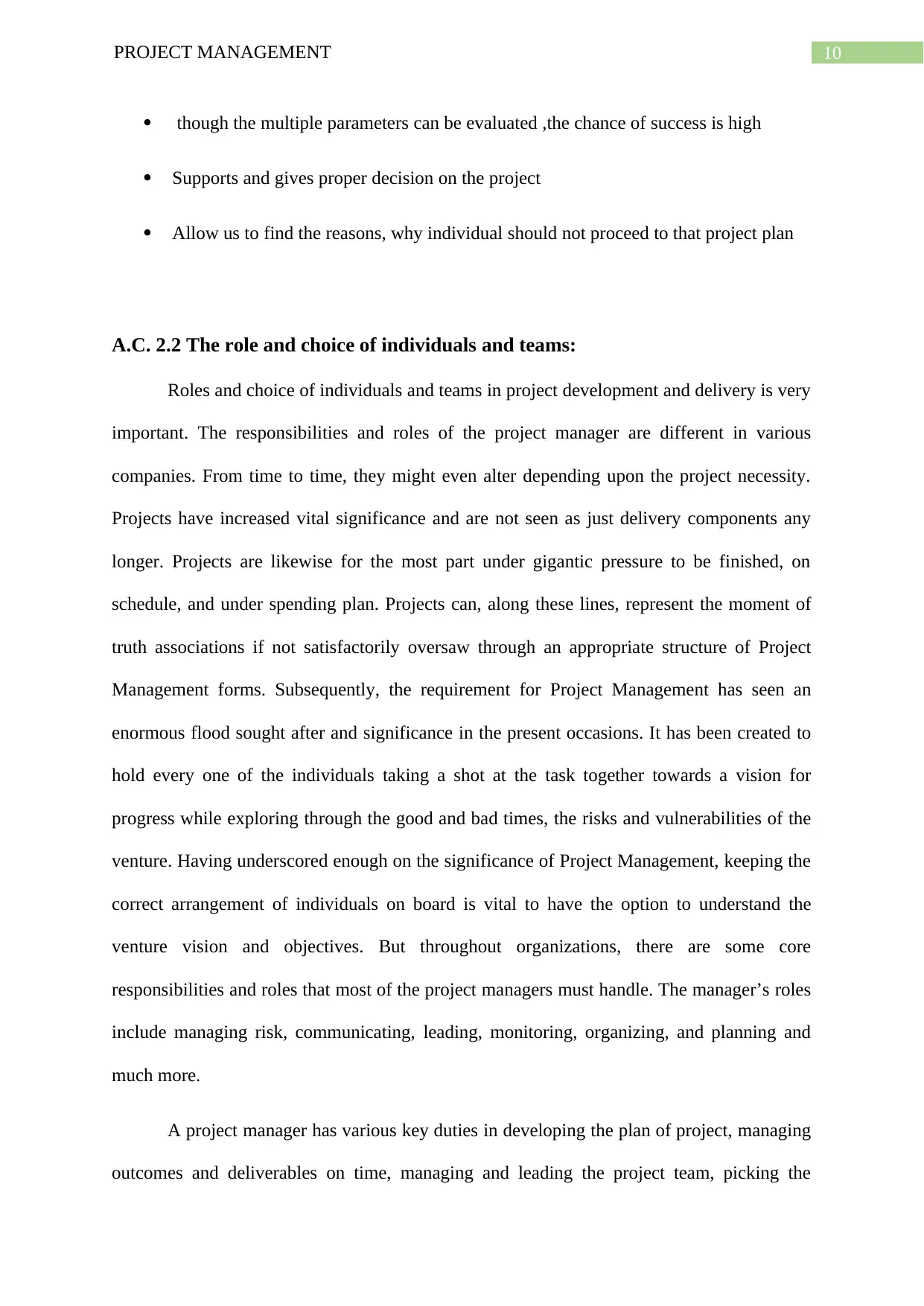
10PROJECT MANAGEMENT
though the multiple parameters can be evaluated ,the chance of success is high
Supports and gives proper decision on the project
Allow us to find the reasons, why individual should not proceed to that project plan
A.C. 2.2 The role and choice of individuals and teams:
Roles and choice of individuals and teams in project development and delivery is very
important. The responsibilities and roles of the project manager are different in various
companies. From time to time, they might even alter depending upon the project necessity.
Projects have increased vital significance and are not seen as just delivery components any
longer. Projects are likewise for the most part under gigantic pressure to be finished, on
schedule, and under spending plan. Projects can, along these lines, represent the moment of
truth associations if not satisfactorily oversaw through an appropriate structure of Project
Management forms. Subsequently, the requirement for Project Management has seen an
enormous flood sought after and significance in the present occasions. It has been created to
hold every one of the individuals taking a shot at the task together towards a vision for
progress while exploring through the good and bad times, the risks and vulnerabilities of the
venture. Having underscored enough on the significance of Project Management, keeping the
correct arrangement of individuals on board is vital to have the option to understand the
venture vision and objectives. But throughout organizations, there are some core
responsibilities and roles that most of the project managers must handle. The manager’s roles
include managing risk, communicating, leading, monitoring, organizing, and planning and
much more.
A project manager has various key duties in developing the plan of project, managing
outcomes and deliverables on time, managing and leading the project team, picking the
though the multiple parameters can be evaluated ,the chance of success is high
Supports and gives proper decision on the project
Allow us to find the reasons, why individual should not proceed to that project plan
A.C. 2.2 The role and choice of individuals and teams:
Roles and choice of individuals and teams in project development and delivery is very
important. The responsibilities and roles of the project manager are different in various
companies. From time to time, they might even alter depending upon the project necessity.
Projects have increased vital significance and are not seen as just delivery components any
longer. Projects are likewise for the most part under gigantic pressure to be finished, on
schedule, and under spending plan. Projects can, along these lines, represent the moment of
truth associations if not satisfactorily oversaw through an appropriate structure of Project
Management forms. Subsequently, the requirement for Project Management has seen an
enormous flood sought after and significance in the present occasions. It has been created to
hold every one of the individuals taking a shot at the task together towards a vision for
progress while exploring through the good and bad times, the risks and vulnerabilities of the
venture. Having underscored enough on the significance of Project Management, keeping the
correct arrangement of individuals on board is vital to have the option to understand the
venture vision and objectives. But throughout organizations, there are some core
responsibilities and roles that most of the project managers must handle. The manager’s roles
include managing risk, communicating, leading, monitoring, organizing, and planning and
much more.
A project manager has various key duties in developing the plan of project, managing
outcomes and deliverables on time, managing and leading the project team, picking the
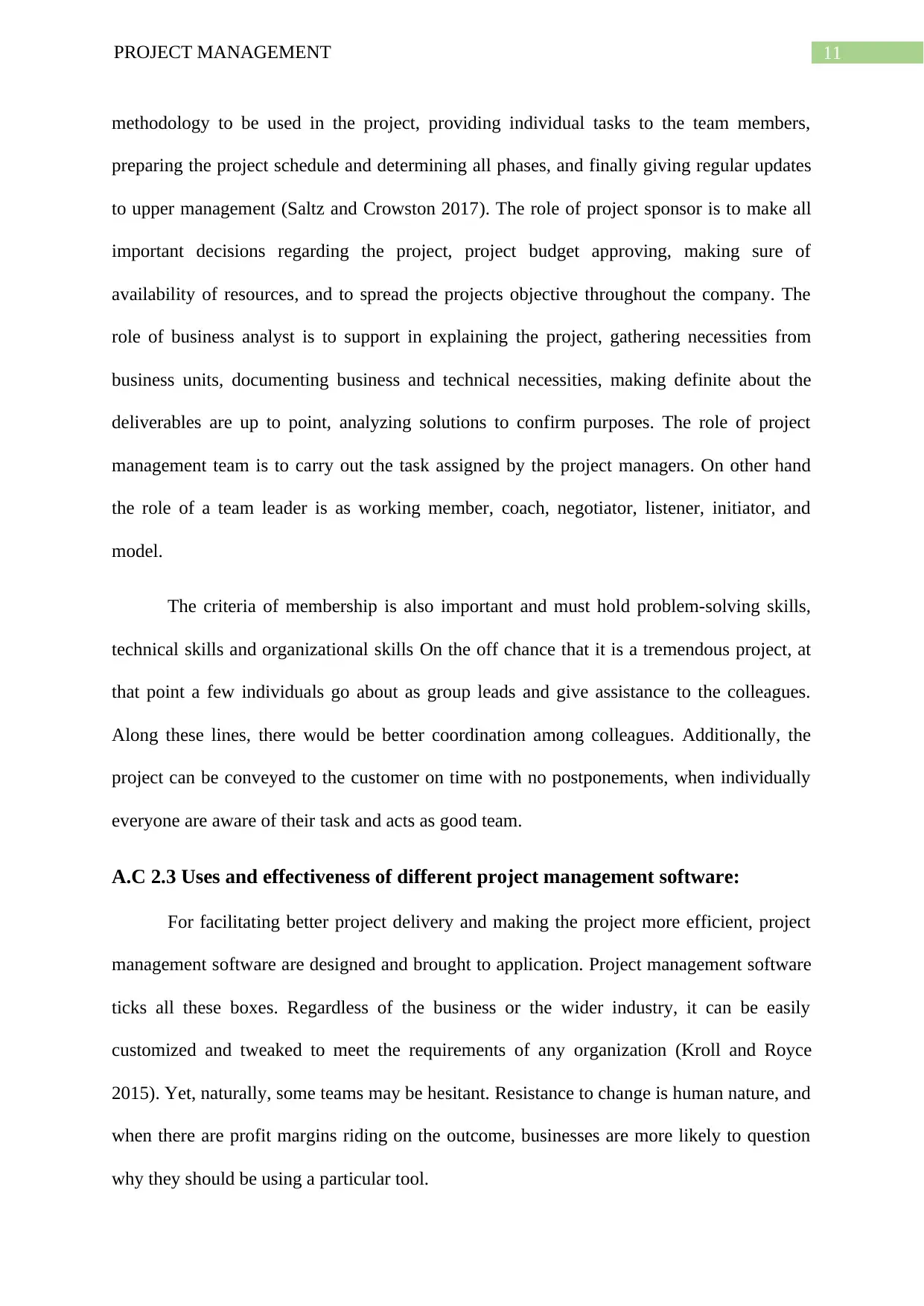
11PROJECT MANAGEMENT
methodology to be used in the project, providing individual tasks to the team members,
preparing the project schedule and determining all phases, and finally giving regular updates
to upper management (Saltz and Crowston 2017). The role of project sponsor is to make all
important decisions regarding the project, project budget approving, making sure of
availability of resources, and to spread the projects objective throughout the company. The
role of business analyst is to support in explaining the project, gathering necessities from
business units, documenting business and technical necessities, making definite about the
deliverables are up to point, analyzing solutions to confirm purposes. The role of project
management team is to carry out the task assigned by the project managers. On other hand
the role of a team leader is as working member, coach, negotiator, listener, initiator, and
model.
The criteria of membership is also important and must hold problem-solving skills,
technical skills and organizational skills On the off chance that it is a tremendous project, at
that point a few individuals go about as group leads and give assistance to the colleagues.
Along these lines, there would be better coordination among colleagues. Additionally, the
project can be conveyed to the customer on time with no postponements, when individually
everyone are aware of their task and acts as good team.
A.C 2.3 Uses and effectiveness of different project management software:
For facilitating better project delivery and making the project more efficient, project
management software are designed and brought to application. Project management software
ticks all these boxes. Regardless of the business or the wider industry, it can be easily
customized and tweaked to meet the requirements of any organization (Kroll and Royce
2015). Yet, naturally, some teams may be hesitant. Resistance to change is human nature, and
when there are profit margins riding on the outcome, businesses are more likely to question
why they should be using a particular tool.
methodology to be used in the project, providing individual tasks to the team members,
preparing the project schedule and determining all phases, and finally giving regular updates
to upper management (Saltz and Crowston 2017). The role of project sponsor is to make all
important decisions regarding the project, project budget approving, making sure of
availability of resources, and to spread the projects objective throughout the company. The
role of business analyst is to support in explaining the project, gathering necessities from
business units, documenting business and technical necessities, making definite about the
deliverables are up to point, analyzing solutions to confirm purposes. The role of project
management team is to carry out the task assigned by the project managers. On other hand
the role of a team leader is as working member, coach, negotiator, listener, initiator, and
model.
The criteria of membership is also important and must hold problem-solving skills,
technical skills and organizational skills On the off chance that it is a tremendous project, at
that point a few individuals go about as group leads and give assistance to the colleagues.
Along these lines, there would be better coordination among colleagues. Additionally, the
project can be conveyed to the customer on time with no postponements, when individually
everyone are aware of their task and acts as good team.
A.C 2.3 Uses and effectiveness of different project management software:
For facilitating better project delivery and making the project more efficient, project
management software are designed and brought to application. Project management software
ticks all these boxes. Regardless of the business or the wider industry, it can be easily
customized and tweaked to meet the requirements of any organization (Kroll and Royce
2015). Yet, naturally, some teams may be hesitant. Resistance to change is human nature, and
when there are profit margins riding on the outcome, businesses are more likely to question
why they should be using a particular tool.
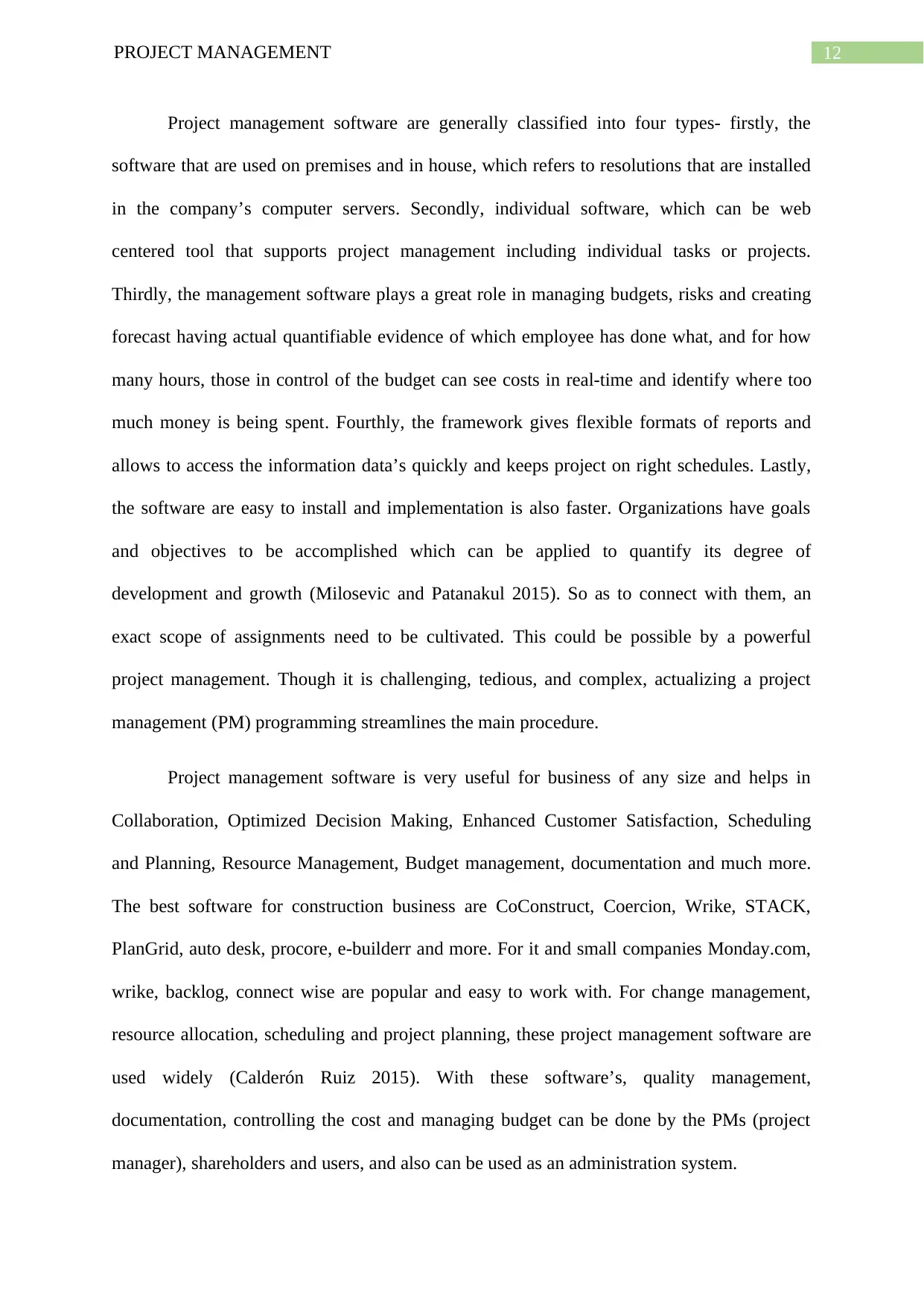
12PROJECT MANAGEMENT
Project management software are generally classified into four types- firstly, the
software that are used on premises and in house, which refers to resolutions that are installed
in the company’s computer servers. Secondly, individual software, which can be web
centered tool that supports project management including individual tasks or projects.
Thirdly, the management software plays a great role in managing budgets, risks and creating
forecast having actual quantifiable evidence of which employee has done what, and for how
many hours, those in control of the budget can see costs in real-time and identify where too
much money is being spent. Fourthly, the framework gives flexible formats of reports and
allows to access the information data’s quickly and keeps project on right schedules. Lastly,
the software are easy to install and implementation is also faster. Organizations have goals
and objectives to be accomplished which can be applied to quantify its degree of
development and growth (Milosevic and Patanakul 2015). So as to connect with them, an
exact scope of assignments need to be cultivated. This could be possible by a powerful
project management. Though it is challenging, tedious, and complex, actualizing a project
management (PM) programming streamlines the main procedure.
Project management software is very useful for business of any size and helps in
Collaboration, Optimized Decision Making, Enhanced Customer Satisfaction, Scheduling
and Planning, Resource Management, Budget management, documentation and much more.
The best software for construction business are CoConstruct, Coercion, Wrike, STACK,
PlanGrid, auto desk, procore, e-builderr and more. For it and small companies Monday.com,
wrike, backlog, connect wise are popular and easy to work with. For change management,
resource allocation, scheduling and project planning, these project management software are
used widely (Calderón Ruiz 2015). With these software’s, quality management,
documentation, controlling the cost and managing budget can be done by the PMs (project
manager), shareholders and users, and also can be used as an administration system.
Project management software are generally classified into four types- firstly, the
software that are used on premises and in house, which refers to resolutions that are installed
in the company’s computer servers. Secondly, individual software, which can be web
centered tool that supports project management including individual tasks or projects.
Thirdly, the management software plays a great role in managing budgets, risks and creating
forecast having actual quantifiable evidence of which employee has done what, and for how
many hours, those in control of the budget can see costs in real-time and identify where too
much money is being spent. Fourthly, the framework gives flexible formats of reports and
allows to access the information data’s quickly and keeps project on right schedules. Lastly,
the software are easy to install and implementation is also faster. Organizations have goals
and objectives to be accomplished which can be applied to quantify its degree of
development and growth (Milosevic and Patanakul 2015). So as to connect with them, an
exact scope of assignments need to be cultivated. This could be possible by a powerful
project management. Though it is challenging, tedious, and complex, actualizing a project
management (PM) programming streamlines the main procedure.
Project management software is very useful for business of any size and helps in
Collaboration, Optimized Decision Making, Enhanced Customer Satisfaction, Scheduling
and Planning, Resource Management, Budget management, documentation and much more.
The best software for construction business are CoConstruct, Coercion, Wrike, STACK,
PlanGrid, auto desk, procore, e-builderr and more. For it and small companies Monday.com,
wrike, backlog, connect wise are popular and easy to work with. For change management,
resource allocation, scheduling and project planning, these project management software are
used widely (Calderón Ruiz 2015). With these software’s, quality management,
documentation, controlling the cost and managing budget can be done by the PMs (project
manager), shareholders and users, and also can be used as an administration system.
Secure Best Marks with AI Grader
Need help grading? Try our AI Grader for instant feedback on your assignments.

13PROJECT MANAGEMENT
Conclusion:
Thus, it can be concluded from the entire report that a decent project management
model can deliver the processes, framework, techniques and guidelines for managing the
persons and attain the project goals. Generally, good models does enhance the odds of
required project success and therefore delivers value to company, the beneficiaries, the donor
and the project. The uses and effectiveness of different project management software has
been discussed in the paper.
Conclusion:
Thus, it can be concluded from the entire report that a decent project management
model can deliver the processes, framework, techniques and guidelines for managing the
persons and attain the project goals. Generally, good models does enhance the odds of
required project success and therefore delivers value to company, the beneficiaries, the donor
and the project. The uses and effectiveness of different project management software has
been discussed in the paper.
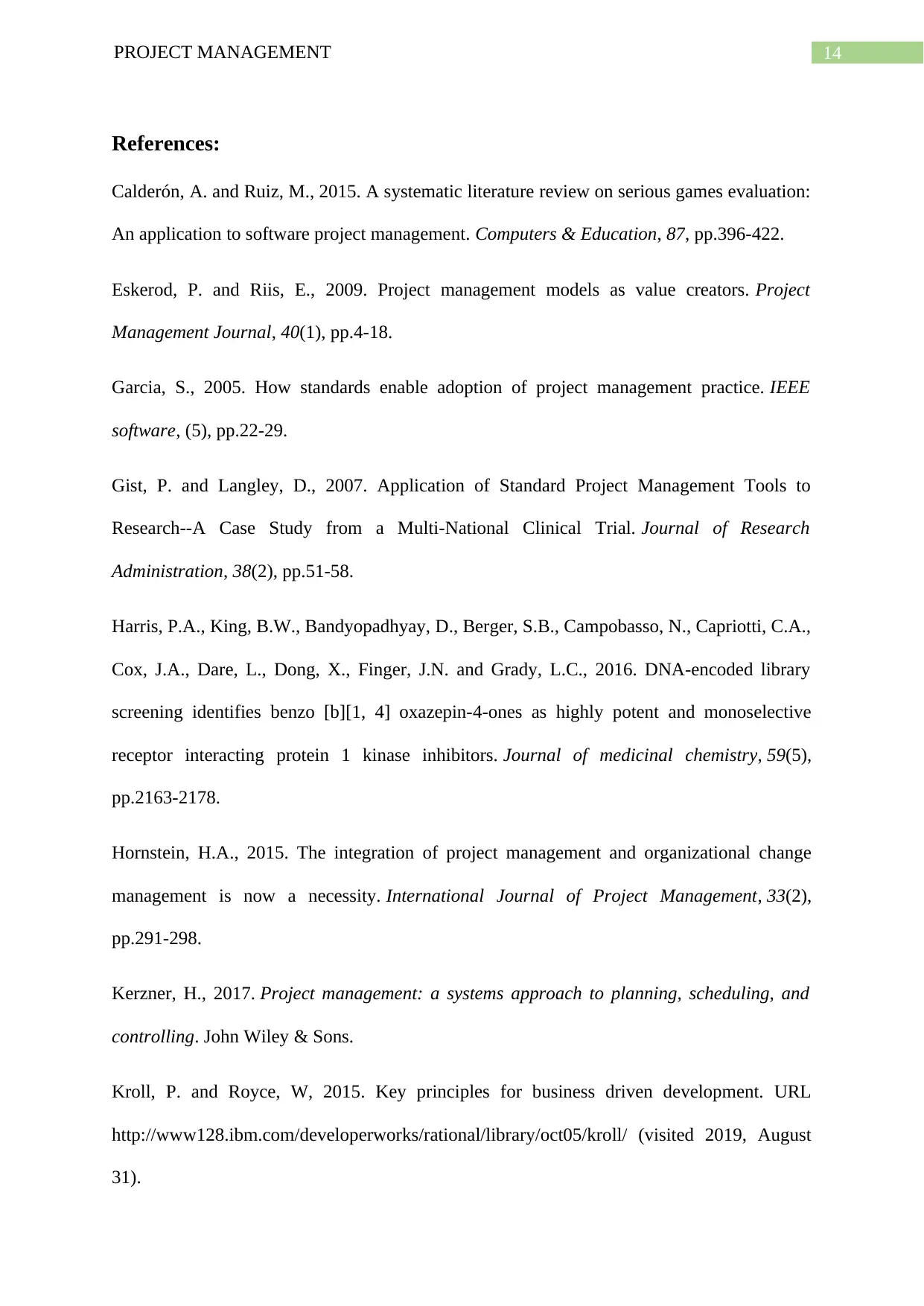
14PROJECT MANAGEMENT
References:
Calderón, A. and Ruiz, M., 2015. A systematic literature review on serious games evaluation:
An application to software project management. Computers & Education, 87, pp.396-422.
Eskerod, P. and Riis, E., 2009. Project management models as value creators. Project
Management Journal, 40(1), pp.4-18.
Garcia, S., 2005. How standards enable adoption of project management practice. IEEE
software, (5), pp.22-29.
Gist, P. and Langley, D., 2007. Application of Standard Project Management Tools to
Research--A Case Study from a Multi-National Clinical Trial. Journal of Research
Administration, 38(2), pp.51-58.
Harris, P.A., King, B.W., Bandyopadhyay, D., Berger, S.B., Campobasso, N., Capriotti, C.A.,
Cox, J.A., Dare, L., Dong, X., Finger, J.N. and Grady, L.C., 2016. DNA-encoded library
screening identifies benzo [b][1, 4] oxazepin-4-ones as highly potent and monoselective
receptor interacting protein 1 kinase inhibitors. Journal of medicinal chemistry, 59(5),
pp.2163-2178.
Hornstein, H.A., 2015. The integration of project management and organizational change
management is now a necessity. International Journal of Project Management, 33(2),
pp.291-298.
Kerzner, H., 2017. Project management: a systems approach to planning, scheduling, and
controlling. John Wiley & Sons.
Kroll, P. and Royce, W, 2015. Key principles for business driven development. URL
http://www128.ibm.com/developerworks/rational/library/oct05/kroll/ (visited 2019, August
31).
References:
Calderón, A. and Ruiz, M., 2015. A systematic literature review on serious games evaluation:
An application to software project management. Computers & Education, 87, pp.396-422.
Eskerod, P. and Riis, E., 2009. Project management models as value creators. Project
Management Journal, 40(1), pp.4-18.
Garcia, S., 2005. How standards enable adoption of project management practice. IEEE
software, (5), pp.22-29.
Gist, P. and Langley, D., 2007. Application of Standard Project Management Tools to
Research--A Case Study from a Multi-National Clinical Trial. Journal of Research
Administration, 38(2), pp.51-58.
Harris, P.A., King, B.W., Bandyopadhyay, D., Berger, S.B., Campobasso, N., Capriotti, C.A.,
Cox, J.A., Dare, L., Dong, X., Finger, J.N. and Grady, L.C., 2016. DNA-encoded library
screening identifies benzo [b][1, 4] oxazepin-4-ones as highly potent and monoselective
receptor interacting protein 1 kinase inhibitors. Journal of medicinal chemistry, 59(5),
pp.2163-2178.
Hornstein, H.A., 2015. The integration of project management and organizational change
management is now a necessity. International Journal of Project Management, 33(2),
pp.291-298.
Kerzner, H., 2017. Project management: a systems approach to planning, scheduling, and
controlling. John Wiley & Sons.
Kroll, P. and Royce, W, 2015. Key principles for business driven development. URL
http://www128.ibm.com/developerworks/rational/library/oct05/kroll/ (visited 2019, August
31).
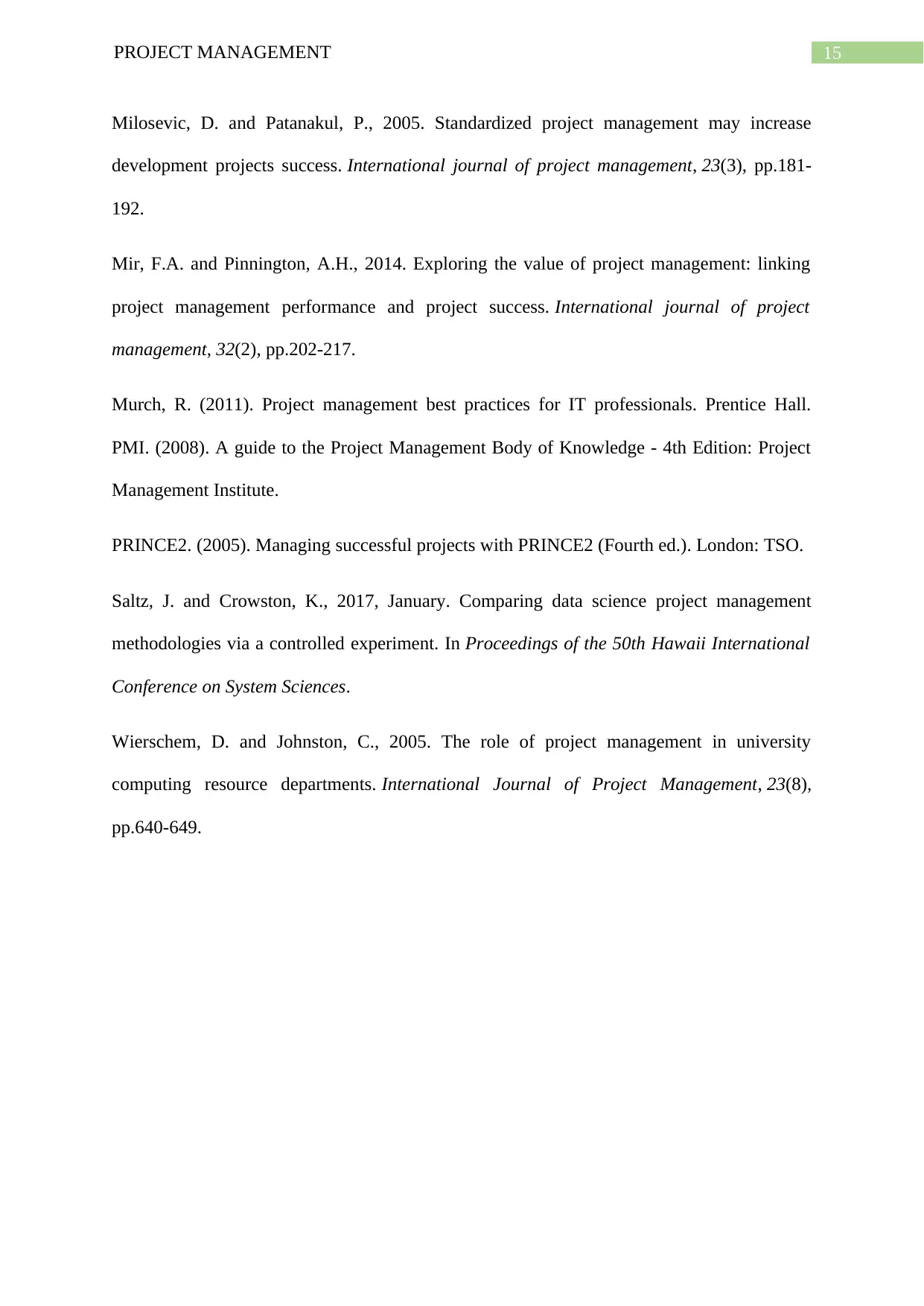
15PROJECT MANAGEMENT
Milosevic, D. and Patanakul, P., 2005. Standardized project management may increase
development projects success. International journal of project management, 23(3), pp.181-
192.
Mir, F.A. and Pinnington, A.H., 2014. Exploring the value of project management: linking
project management performance and project success. International journal of project
management, 32(2), pp.202-217.
Murch, R. (2011). Project management best practices for IT professionals. Prentice Hall.
PMI. (2008). A guide to the Project Management Body of Knowledge - 4th Edition: Project
Management Institute.
PRINCE2. (2005). Managing successful projects with PRINCE2 (Fourth ed.). London: TSO.
Saltz, J. and Crowston, K., 2017, January. Comparing data science project management
methodologies via a controlled experiment. In Proceedings of the 50th Hawaii International
Conference on System Sciences.
Wierschem, D. and Johnston, C., 2005. The role of project management in university
computing resource departments. International Journal of Project Management, 23(8),
pp.640-649.
Milosevic, D. and Patanakul, P., 2005. Standardized project management may increase
development projects success. International journal of project management, 23(3), pp.181-
192.
Mir, F.A. and Pinnington, A.H., 2014. Exploring the value of project management: linking
project management performance and project success. International journal of project
management, 32(2), pp.202-217.
Murch, R. (2011). Project management best practices for IT professionals. Prentice Hall.
PMI. (2008). A guide to the Project Management Body of Knowledge - 4th Edition: Project
Management Institute.
PRINCE2. (2005). Managing successful projects with PRINCE2 (Fourth ed.). London: TSO.
Saltz, J. and Crowston, K., 2017, January. Comparing data science project management
methodologies via a controlled experiment. In Proceedings of the 50th Hawaii International
Conference on System Sciences.
Wierschem, D. and Johnston, C., 2005. The role of project management in university
computing resource departments. International Journal of Project Management, 23(8),
pp.640-649.
1 out of 16
Related Documents
Your All-in-One AI-Powered Toolkit for Academic Success.
+13062052269
info@desklib.com
Available 24*7 on WhatsApp / Email
![[object Object]](/_next/static/media/star-bottom.7253800d.svg)
Unlock your academic potential
© 2024 | Zucol Services PVT LTD | All rights reserved.





